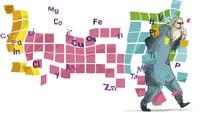Dmitri Mendeleiev, advertiser of elements

Maria Dmitrievna Mendeleieva was clear that in her 14 children the youngest, Dmitri, was going to study university. It was not easy. When Dmitri was 14, the crystal factory, the family's only source of income, burned and Mary became a widow for a few months. The modest fortune to pay for his son's studies led him from Tobolsk (Siberia) to Moscow on a journey of 2,000 kilometers.
However, at the University of Moscow they did not accept external students and had to continue traveling to St. Petersburg. There they also found the same obstacle. But fortunately they found a friend of Father Dmitrien working at the Pedagogy Institute and thanks to him Dmitri got a scholarship to study in the center. His mother died very soon after.
Years later, Dimitri Mendeleiev would remember his mother's effort in a book: "This study is dedicated by his youngest son to the memory of a mother. Leading a factory, he could only give training to his son thanks to his work. He taught him as an example, led with affection and to put his son on the path of science, he left Siberia, spending on it his last resources and strength."
And Mendeleiev advanced on the path of science. He finished his studies in 1856 and obtained a post of professor. Subsequently, to improve his scientific training, he was awarded a scholarship to travel abroad for two years. After visiting a dozen universities across Europe, he decided to stay in Heidelberg working with Dr. Bunsen, Erlenmeyer and Kirchhoff. However, in view of the non-existence in Bunsen's laboratory of precision equipment he needed, he made a new laboratory in his apartment.
Although he tried to prolong his stay in Heidelberg, he did not get permission and had to return to St. Petersburg in 1861. He returned to work as a professor, first at the Institute of Technology and, from 1865, at the university. There, seeing that there was no suitable textbook for teachers, he decided to write it. And so he published it in 1869 Osnovy Khimi (Fundamentals of Chemistry). He was one of the best chemistry books of the time and was soon translated into German, English and French. In that book Mendeleiev published his greatest contribution to science: the periodic table.
Previously other scientists, such as Chancourtois or Newlands, proposed that ordering the chemical elements by their atomic weight was obtained a certain periodicity in the properties of the elements. But this was only achieved with a few elements and no one succeeded. Also Mendeleiev had been looking for some order in the chemical elements for years. And in the end he also ordered them by his atomic weight, but took another step: to fulfill the periodicity of the properties of the elements he introduced gaps in the table, reasoning that those places could still be of undiscovered elements. Thus, he called eka-aluminium and dvi-aluminium the hollows that have been left under aluminium (sanscrítica, eka=1 and dvi=2), under silica, eka-silicon, etc. In this way he managed to order in a table the 63 elements known at that time. In that table the elements that were in the same column had similar properties.
In addition, it gave such importance to the properties of the elements that it proposed that a dozen elements had poorly calculated atomic weights and was right. It even announced properties of elements that were not yet known with the table. The eca-aluminum, for example, would be silver, with a density of 6 g/cm 3 and an atomic weight of 68.
At first, the gaps and predictions of the Mendeleiev table provoked ridicule and laughter. But in 1875 the French chemist Lecoq de Boisbaudran discovered a new metal that he called galio. And when he discovered his properties, Mendeleiev declared that the metal was his eco-aluminum. Not only that, he suggested that the density estimated by Boisbauaran (4.9 g/cm 3) was incorrect. Boisbaudran again measured with a better metal purification and was surprised: Mendeleiev was right!
In the next ten years the Eka-boroa and the Eka-silicio were also found, and to find other elements announced by Mendeleiev it would be necessary 50 more years. But with these full predictions, scientists discovered that the Mendeleiev table was more than an arbitrary arrangement of the elements, which was a reflection of reality.
Mendeleiev's fame grew. He was one of the most prestigious speakers of the time and advisor to the Russian government. He carried out various studies to advance the technologies of his country, proposing improvements for agriculture and industry. And he liked to teach his knowledge to all who could. When travelling by train, he went to class 3 to speak to farmers. The peasants gathered around Mendeleiev to listen to their lessons.
He also loved university teaching. And he was always very close to the students. On one occasion, he was expelled from college for his defense in a student protest. The police detained him during the class accusing him of pushing his students into rebellion. However, he soon returned to college.
He was famous, but he was not given Nobel. He was appointed in 1905, but the prize went to Bayer. In 1906 he was re-elected, but Moissan won by a single vote. And he was appointed third, on January 31, 1907. It was too late. He died on February 2.
In the procession of the funeral the streets were hung, and in front of the procession the students of Mendeleev with the periodic tables in their hands.





